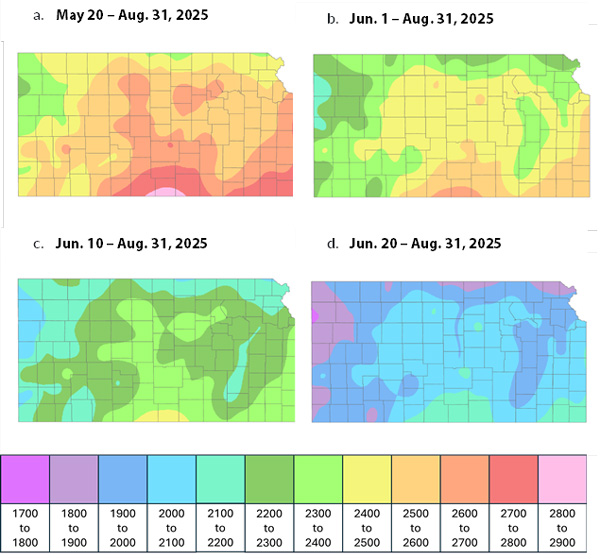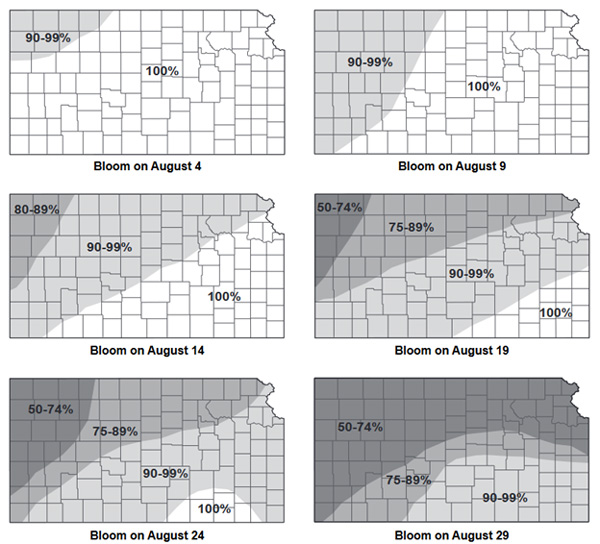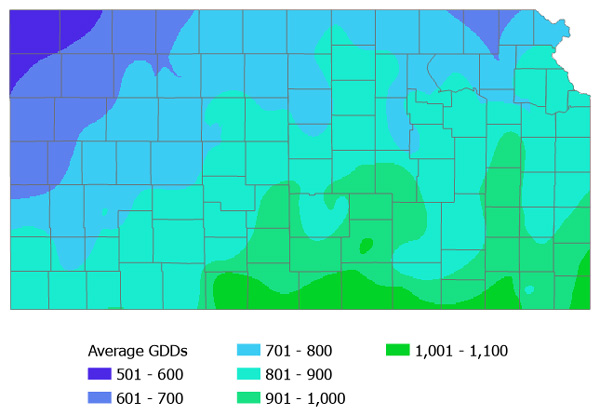With the cooler-than-average temperatures, questions have come up regarding growing degree units (GDU) and how far behind their accumulation might be for later-maturing crops like grain sorghum. Grain sorghum is much like corn and cotton, which need to hit growing degree unit thresholds to move through growth stages and to finish grain (Table 1). Most sorghum hybrids grown in Kansas require around 1400 to 2000 GDUs to reach mid-bloom. One key difference in GDUs for sorghum compared to corn is that the maximum temperature used in accumulating growing degree days is 100°F in sorghum compared to 86°F in corn.
It’s important to note that the main differences in heat units (and thus time) for the progression of a short-season compared to a full-season sorghum hybrid are in the vegetative stages. Short-season hybrids generally produce fewer leaves before reaching boot. After the boot stage, the number of GDU’s needed for progression to physiological maturity is similar for short and full-season hybrids.
Table 1. The cumulative GDUs required to reach key growth stages in grain sorghum and the remaining GDUs required to reach black layer.
|
Cumulative GDUs |
Growth Stage |
GDUs to Black Layer |
||
|
Med Early |
Med Late |
Med Early |
Med Late |
|
|
99 |
198 |
Emergence |
2457 |
2808 |
|
252 |
360 |
Third Leaf |
2304 |
2646 |
|
396 |
594 |
Fifth leaf |
2160 |
2412 |
|
702 |
1152 |
GPD |
1854 |
1854 |
|
954 |
1404 |
Flag Leaf |
1602 |
1602 |
|
1206 |
1647 |
Boot |
1350 |
1359 |
|
1440 |
1908 |
Mid Bloom |
1116 |
1098 |
|
1746 |
2196 |
Soft Dough |
810 |
810 |
|
2196 |
2646 |
Hard Dough |
360 |
360 |
|
2556 |
3006 |
Black Layer |
0 |
0 |
Cumulative sorghum GDUs are generally greatest in south central and southeast Kansas and least in northwest Kansas, regardless of planting date, because of a combination of latitude and altitude differences. As of August 31:
- For sorghum planted on May 20, GDU accumulation ranged from 2200 to 2900, but declined rapidly with later planting dates (Figure 1).
- For sorghum planted on June 1, cumulative GDUs ranged from 2100 to 2700.
- For sorghum planted on June 10, cumulative GDUs ranged from 2000 to 2500.
- For sorghum planted on June 20, cumulative GDUs ranged from 1700 to 2200.

Figure 1. Contour plot of accumulated growing degree days for sorghum (GDDs) across Kansas during four different planting dates (May 20, June 1, June 10, and June 20).
Using long-term weather data, Figure 2 shows the probabilities for a medium maturity sorghum hybrid reaching maturity before the typical first fall freeze. This graphic is from the K-State Sorghum Production Handbook, https://bookstore.ksre.ksu.edu/pubs/grain-sorghum-production-handbook_C687.pdf.

Figure 2. Probability of sorghum maturing before freeze for flowering dates from August 4 through August 29. From K-State C687, Sorghum Production Handbook.
When looking at these sets of maps together, for the June 20 planting date, areas of the western ¼ of the state and northern Kansas have accumulated 1700 to 2000 GDU’s, meaning most sorghum hybrids planted on June 20 would be mid-bloom to soft dough at the end of the month, assuming normal progression of the plant. Incorporating the information from Figure 2, there is certainly some risk that medium and full season hybrids planted at the end of the planting window may not fully mature.
It’s important to note that a key characteristic of sorghum it’s its ability to “shut down” and delay phenological development when under severe drought stress. The estimated GDUs for each growth stage assume normal progression of the plant. If the plant slows and stops development due to drought and then revives after late season precipitation, then obviously it will take more heat units than estimated to reach maturity.
At the fringes of the season, small differences in bloom date can make large differences in the probability of success. For example, a bloom date of August 24 compared to August 29 drastically shifts the probabilities of success for much of western Kansas.
Kansas during four different time periods.
The average first fall freeze date in Kansas ranges from September 30 – October 4 in northwest Kansas to October 28 to November 1 in south central and southeast Kansas. The expected number of GDDs for sorghum from September 1 through the average date of first freeze is shown in Figure 3.

Figure 3. Expected average of accumulated GDUs for sorghum from Sept. 1 until the average date of first freeze for Kansas. Map generated by Matthew Sittel/K-State Weather Data Library.
Will sorghum reach maturity before the first freeze?
The answer is, “it depends.” We will continue to monitor sorghum growth and development throughout the remainder of the growing season. If the sorghum is killed by a freeze before maturity, producers should first analyze the crop for the test weight and yield potential before making any decisions about grazing or harvesting the crop for silage.
For more information on this, see “Harvesting Grain from Freeze-damaged Sorghum,” K-State publication MF-1081: http://www.ksre.ksu.edu/bookstore/pubs/mf1081.pdf.
Lucas Haag, Agronomist-in-charge at Tribune
lhaag@ksu.edu
Logan Simon, Southwest Area Agronomist
lsimon@ksu.edu
Tina Sullivan, Northeast Area Agronomist
tsullivan@ksu.edu
Matthew Sittel, Assistant State Climatologist
msittel@ksu.edu
Tags: grain sorghum crop development growing degree days first freeze